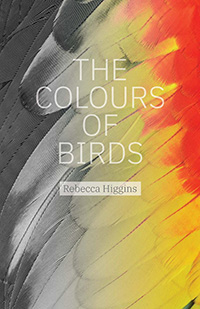Reviews
Fiction Review by Amy Attas
Rebecca Higgins, The Colours of Birds (Toronto: Tightrope, 2018). Paperbound, 144 pp., $21.95.
 The Colours of Birds is the delicate debut by Toronto writer Rebecca Higgins, completed under the guidance of her Humber School for Writers mentor, Helen Humphreys. The characters in this collection of short stories pull heavily from Higgins’s professional background in social work and mental health education, and readers meet them not at moments of grand crisis but in subtle daily struggles. Higgins recognizes that human suffering is often a slow erosion, as of rock by water, and not always the dramatic destruction of a volcanic eruption.
The Colours of Birds is the delicate debut by Toronto writer Rebecca Higgins, completed under the guidance of her Humber School for Writers mentor, Helen Humphreys. The characters in this collection of short stories pull heavily from Higgins’s professional background in social work and mental health education, and readers meet them not at moments of grand crisis but in subtle daily struggles. Higgins recognizes that human suffering is often a slow erosion, as of rock by water, and not always the dramatic destruction of a volcanic eruption.
We’re taken to the poverty-stricken life of east-coast painter Maud Lewis, who bickers with her husband over the price of her paintings in the title story, “The Colours of Birds.” We follow a grocery clerk who obsessively collects receipts in search of the motivation to change her life in “Eggplant Baby.” The thin volume reads like a poetry collection, as individual stories are succinct—sometimes less than a page—and tales are thematically intertwined.
Some of these stories are more successful than others. “Everything Inside,” about a New Orleans couple clinging together in the aftermath of Hurricane Katrina, presents well-selected details that set the scene but don’t clutter. The couple at the story’s centre are flawed without being dreary. They hold onto hope as they struggle through the storm’s aftermath, while still carrying the baggage of their stagnant relationship. Other stories feel weighted by the detritus of suburban existence, the reader and characters slogging through the truly mundane details of uninspired lives. It’s difficult to tell if this is symptomatic of a rookie writer or a conscious choice to drag readers through the muck of a futile world view. Either way, the effect is unsettling. There is little relief, and little hope. Don’t buy a new outfit for your first date, he’s not taking you anywhere special. Don’t bother dieting, you’re going to die of some random disease before health has a chance to take hold. No wonder these characters are lonely and unhappy, when their lives are weighted with tired conversations and passionless hobbies.
The moments of most startling power occur when Higgins’s expertise in mental health colludes with more elegant language, as in “The White Stain,” about painter Lee Krasner mourning the death of her husband, Jackson Pollock:
Lee moves to the window and opens it wider. At her worst, the one thing she can bear, the only thing that isn’t searing, is the sound of wind. Outside, the trees are slowly undressing themselves for winter. Many of their leaves are already covering the wild garden, and more fall as the wind takes them. She wonders why trees are naked during the coldest months, when everything else does its shedding in the summer. She shivers in her thin white dress and lies down on her bed. She curls further into herself instead of shutting the window, sticks her feet under a knitted blanket piled at the foot of the bed. The wind cycles from crescendo to silence, and it seems to her that it grows louder each time it rises. This soothes her, and she slides into half sleep, listening to the wind.
This description is less suffocating than the long list of ingredients a strained mother reads off an index card in “Windpipe,” making “The White Stain” more like Margaret Atwood and “Windpipe” more Gertrude Stein. The narrator in “The White Stain” speaks with more beauty and self-awareness, helping readers see Lee’s choices and opinions.
The Colours of Birds asks us to dive, over and again, into the minds of unhappy people, and it’s difficult reading. But it’s also validating to have those feelings so accurately described. In “Clara and Rosemary,” Higgins puts the reader squarely into the brain-fog of hurt and short circuits: “and the grief is sand in her throat and glue under her boots and skittering mice in her head.” Then, in “Stoplight,” a similar feeling of stress and detachment is given a less poetic rendering: “I felt really weird, like I was going to choke on my heartbeat. My hairline started itching really badly, and my lips felt thick. The driver radioed his dispatch. We heard him say, voice quivering, ’I think I hit something.’” It is insightful to emphasize the physical symptoms of mental stress, but the words here lack weight. Would this paragraph hit harder if “really weird” were removed, and “really badly” replaced with one of Higgins’s creative similes? Or would that take readers out of the narrator’s authentic voice?
This collection shows us life under harsh fluorescent lights: its stories as unflattering as they are clear. Readers can mourn the pallid hue of once-rosy lives, while appreciating the veracity and careful composition of each tale.
—Amy Attas









